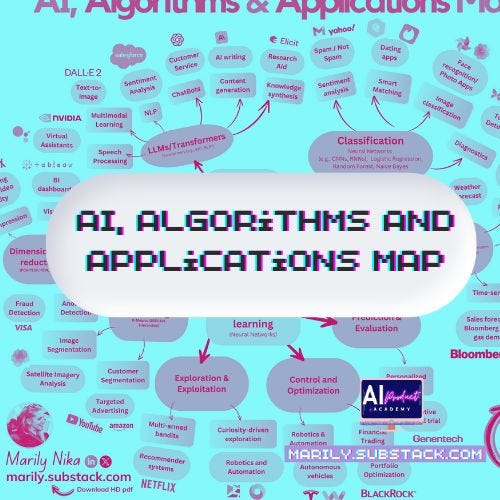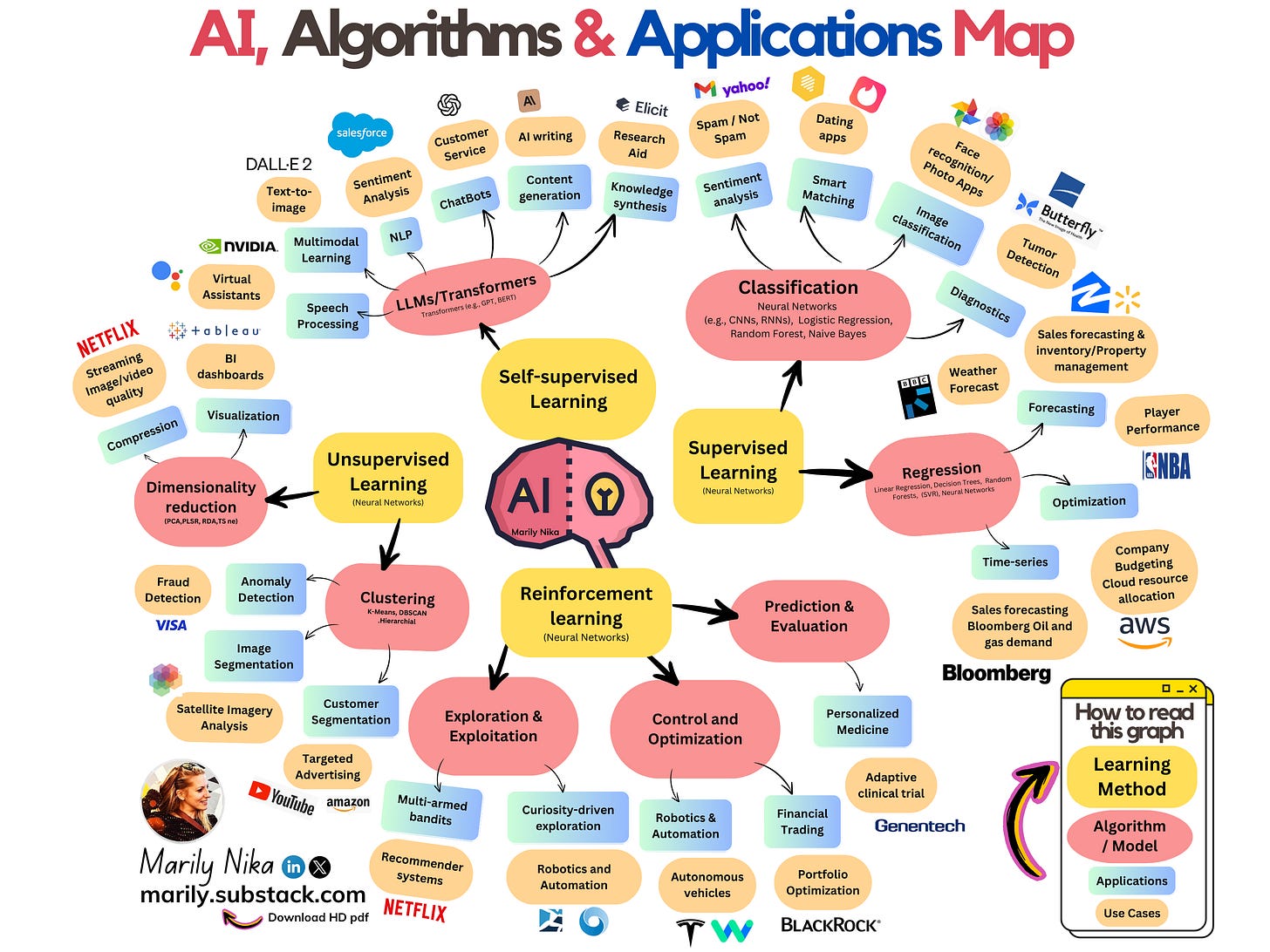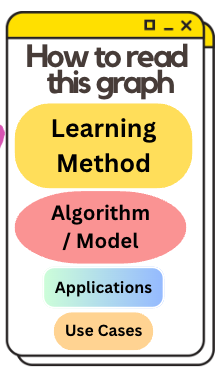It's here. Marily's map of AI, Algorithms & Applications 🗺️🧠
Or in other words, AI's superpowers
I've been working on this for many months now, constantly tweaking it because it never seems quite ready, symmetrical, or comprehensive enough. However, after running it by a few trusted individuals, all three encouraged me to 'just post it.' So, here goes.
Me talking at TED AI about how AI is not a product
The map of AI, Algorithms & Applications
Here is the map of AI, Algorithms, and Applications, or in other words, what kind of AI superpower, enables what kind of AI product.
There is, of course, no one-size-fits-all recipe, and there is significant overlap in these categories. However, my hope in creating this for you is to help you map out the different types of learning methods, algorithms, applications, use cases, and real-world examples. I welcome feedback but please note this is not meant to serve as an engineering resource, and there are really infinite ways to visualize this, so I am not optimizing for accuracy, just for knowledge sharing (and fun!).
Marily's Map of AI, Algorithms & Applications © 2024 by Marily Nika is licensed under Creative Commons Attribution-NonCommercial-NoDerivatives 4.0 International
AI is not a Product. It is a suite of technologies and methodologies that *empower* a wide array of products and solutions across various industries. The map I created offers a detailed overview of how these technologies converge to create impactful and innovative applications. Let’s explore the map starting from its core concepts to the practical applications, demonstrating how AI components are integrated into real-world scenarios.
Here’s how to read my graph:
Learning Method: A learning method in AI refers to the approach or technique used to train a machine learning model. This method determines how a model learns from data to make predictions or decisions.
Algorithm/Model: An algorithm in AI is a set of rules or instructions designed to perform a specific task or to solve a particular problem. A model in AI is a specific implementation of an algorithm that has been trained on data to predict outcomes or understand patterns (I bundled these two due to the intertwined nature of these concepts).
Applications: An application refers to the practical use of an AI model or algorithm to perform specific tasks that are valuable in real-world scenarios, or in other words, the AI product itself.
Use Cases: You know what this is. How a product or feature can solve a problem or fulfill a need for its users. It’s a scenario in which AI technology can be applied to solve a problem or enhance a process in a specific context.
Let’s dive in
Let's dive deeper into the foundational AI learning methods starting with those in the yellow elements of the map, specifically: Self-supervised Learning, Supervised Learning, Reinforcement Learning, and Unsupervised Learning. Here’s a detailed breakdown of each:
Self-supervised Learning
Self-supervised learning is a type of machine learning where the system learns to understand data by itself, without explicit labels provided by humans. Instead, it generates its own labels from the data by predicting missing parts or properties of the data. This method is pivotal in developing models that can learn from large volumes of unlabeled data, making it especially useful for tasks like natural language understanding, where labeled data can be scarce or expensive to produce.
Technologies and Functionalities
LLMs/Transformers: Large Language Models (LLMs) and transformers are crucial in self-supervised learning for understanding and generating human-like text. These models, trained on vast amounts of text data, can predict text continuation and generate coherent pieces of text.
Speech Processing: Self-supervised learning is used to develop models that can transcribe speech without needing labeled data, by predicting the next word or sound in sequences.
Multimodal Learning: Involves training models to process and integrate information from different types of data, such as text and images, to perform tasks like automatic captioning.
NLP (Natural Language Processing): Self-supervised techniques are extensively used to improve language models that power applications such as sentiment analysis and language translation.
Chatbots: Utilizing advanced NLP capabilities, self-supervised learning helps chatbots generate more relevant and context-aware responses.
Content Synthesis: Enabling the automated creation of content, such as articles and reports, that feels natural and human-like.
Real World Applications and Use Cases
GenMedia: Likely a hypothetical or generic representation of media companies using technologies like transformers for content generation and media analysis.
Salesforce: Uses AI for enhancing customer relationship management through chatbots and other NLP-driven applications.
Supervised Learning
Supervised learning involves training a model on a labeled dataset, which means that each piece of data in the training set is paired with the correct answer or outcome. This is the most common type of learning used in AI, suitable for a wide range of applications from image recognition to predicting consumer behavior. It requires a substantial amount of labeled data and is generally used where the outputs are known and need to be predicted based on new inputs.
Technologies and Functionalities
Classification:
Sentiment Analysis: Analyzing text data from reviews or social media to determine the sentiment (positive, negative, neutral).
Smart Matching: Using AI to match users or products in services such as dating apps or job portals based on learned preferences.
Image Classification: Identifying objects within an image and categorizing them into predefined classes.
Diagnostics: In healthcare, using image data to diagnose diseases from scans or tests.
Regression:
Forecasting: Predicting future values such as sales or stock prices based on historical data.
Optimization: Adjusting inputs to maximize or minimize certain outcomes, useful in logistics and resource allocation.
Time-series Analysis: Analyzing time-ordered data points to predict future points or trends.
Applications and Use Cases
Butterfly Network, Zebra Medical Vision: Companies using supervised learning for medical diagnostics through image classification.
Yahoo!: Could be employing forecasting and optimization for various business processes like ad placements.
Reinforcement Learning
Reinforcement learning is a type of machine learning where an agent learns to make decisions by performing actions in an environment and receiving rewards or penalties in return. It's used in scenarios where decision-making is sequential and the correct action in each situation is not known beforehand. This method is heavily employed in gaming, autonomous vehicles, and for optimizing decision-making processes in various fields.
Technologies and Functionalities
Prediction & Evaluation:
Personalized Medicine: Tailoring healthcare treatments to individual patients based on predicted outcomes from different treatment plans.
Control & Optimization:
Financial Trading: Using AI to make buy or sell decisions in real-time trading scenarios.
Robotics and Automation: Programming robots to perform tasks independently in manufacturing or service environments.
Exploration & Exploitation:
Multi-armed Bandits: A problem setup in which an algorithm must choose between multiple options with uncertain returns, optimizing for maximum reward.
Curiosity-driven Exploration: Encouraging AI systems to explore new or less-understood environments or datasets to improve learning.
Applications and Use Cases
Netflix: Using multi-armed bandit algorithms for personalizing viewing recommendations.
BlackRock: Employing financial trading algorithms that optimize portfolio returns.
Unsupervised Learning
Unsupervised learning involves training a model on data that has not been labeled, annotated, or classified. The model learns without any guidance, finding patterns and relationships in the input data. This method is crucial for discovering hidden patterns or intrinsic structures within data. It is often used for clustering, association, and dimensionality reduction tasks in datasets where we do not know the outcome in advance.
Technologies and Functionalities
Clustering:
Anomaly Detection: Identifying unusual patterns or outliers in data, useful in fraud detection.
Image Segmentation: Dividing an image into multiple segments based on the similarity of pixels.
Customer Segmentation: Grouping customers based on purchasing behavior or preferences to tailor marketing strategies.
Dimensionality Reduction:
Compression: Reducing the size of data while maintaining its essential features, crucial for storage and analysis.
Visualization: Transforming high-dimensional data into visual formats that are easier to understand and analyze.
Applications and Use Cases
Visa: Likely uses anomaly detection for identifying fraudulent transactions.
Amazon, YouTube: Utilize customer segmentation to enhance user recommendations and targeted advertising.
🚨🚨🚨 Interested in downloading the HD version of this? Or perhaps, would you like a PRINTED version shipped to you? Upgrade to a paid subscription for my newsletter. If you choose the annual subscription, I will ship this to you
Keep reading with a 7-day free trial
Subscribe to Marily Nika’s AI Product Academy Newsletter to keep reading this post and get 7 days of free access to the full post archives.







